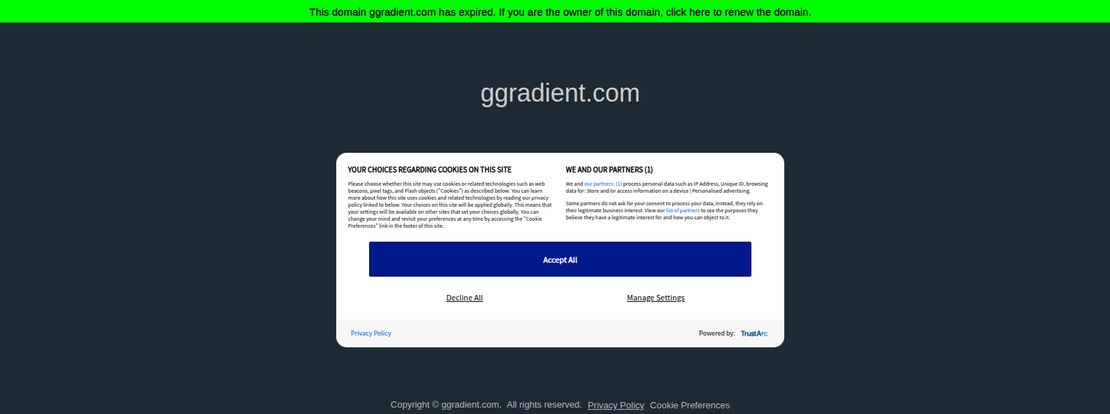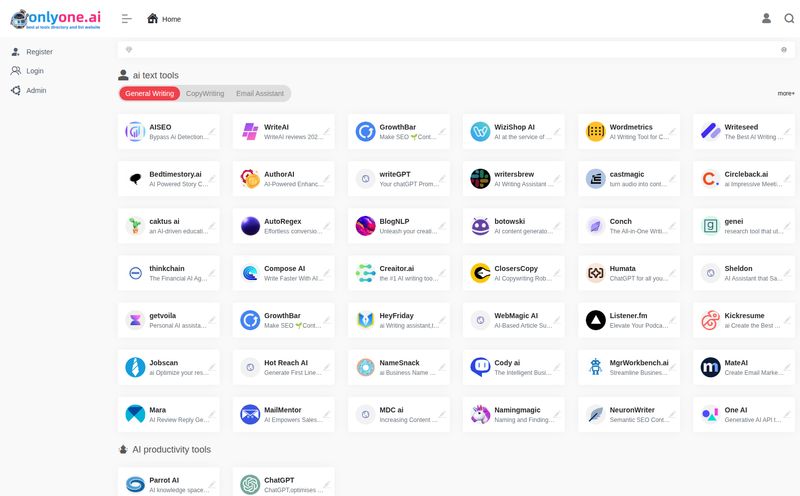You know that feeling, right? You stumble across a perfect little web tool. It’s elegant, does one thing incredibly well, and saves you a ton of time. You bookmark it, use it a few times, and it becomes part of your trusted digital toolkit. Then one day, you go back, and… it’s gone. Poof. Vanished into the digital ether.
That’s the story I ran into this week with a site called ggradient.com. I’d heard whispers about it being a nifty, no-fuss CSS gradient generator. As someone who’s spent more hours than I’d like to admit manually tweaking HSL values and comma placements in CSS, a good visual generator is like finding a perfectly sharp chisel. It just makes the work cleaner.
But when I navigated to the site, I wasn’t greeted with a slick UI of color stops and angle sliders. Instead, I found this.

Visit Awesome CSS Gradient generator
A simple, sad little message: “This domain ggradient.com has expired.” It's the digital equivalent of a “Closed for Business” sign on a favorite old shop. So, let's pour one out for a fallen tool and talk about what it was, why these tools matter, and where we can go now to get our gradient fix.
What Exactly Was ggradient.com Supposed to Be?
From what I can gather, ggradient.com was a straightforward, free tool designed for one purpose: creating advanced CSS gradients. Think beyond the simple two-color linear fades. We’re talking multi-step, complex, radial, and conic gradients that can really make a design pop.
Manually writing the code for these can be a real pain. You have to get the syntax just right, manage all the vendor prefixes for older browser support (though that's less of a headache these days, thankfully), and visualize the whole thing in your head. It’s not impossible, but it’s tedious. A visual CSS gradient tool lets you skip the grunt work and get straight to the creative part. You can drag sliders, click on color pickers, and see the result instantly. It’s the difference between describing a sunset with words and just painting it.
The Allure of Visual Gradient Builders
I've always felt that the best developer tools are the ones that get out of your way. They shouldn't have a steep learning curve or a million features you’ll never touch. They should solve a specific, nagging problem. And that's the niche that tools like ggradient.com aimed to fill.
The main selling point was its supposed ease of use and the time it saved. For a front-end developer or a designer who's deep in the CSS trenches, shaving 15-20 minutes off building a complex background is a huge win. That’s time you can spend on more important things, like accessibility, performance, or just getting a coffee.
Some might argue that relying on generators makes you a 'lesser' developer. I call nonsense on that. Do carpenters feel bad for using a power saw instead of a handsaw? Of course not. It's about using the right tool for the job to be more efficient and produce better work. A visual editor allows for happy accidents and experimentation that you might not try if you were coding every single step by hand.
The Inevitable Downsides of a Focused Tool
Of course, no tool is perfect. Even when it was presumably up and running, ggradient.com had its limitations. From the get-go, it was only ever about CSS gradients. You couldn’t use it for box-shadows, typography, or anything else. It was a specialist, not a generalist. For some, that focus is a feature, not a bug. For others, it means having to keep a whole folder of bookmarks for different little CSS generators.
There was also the small hurdle that to really get the most out of it, you probably needed a basic understanding of how CSS gradients work in the first place. You needed to know what a 'color stop' was or the difference between a linear and a radial gradient. It wasn't for absolute beginners, but more for practitioners looking to speed up their workflow. Which, to be fair, is a pretty big audience.
So, Where Do We Get Our Gradients Now? The Best Alternatives
The demise of one tool, however sad, opens the door to discover others. The web is full of amazing resources built by talented people, often for free. If you're looking for a new CSS gradient generator to add to your bookmarks, here are a few of my go-to's that are very much alive and kicking.
CSSGradient.io
This is probably the king of gradient tools right now. It's incredibly powerful, visually intuitive, and has a ton of options. You can easily create standard gradients, but it also has a library of beautiful, pre-made gradients that are perfect for inspiration. It's more than just a generator; it’s a whole gradient ecosystem. Plus, the UI is just chef's kiss.
MyColor.Space
This one is a bit different and I absolutely love its approach. You start with a single color, and it generates a whole range of beautiful color palettes and gradients based on that color. It's less about granular control and more about color theory and discovery. If you're ever stuck on a color scheme, this is the place to start. It can generate 2-color and 3-color gradients that are almost always gorgeous.
ColorZilla's Gradient Editor
An oldie but a goodie. ColorZilla has been around for what feels like forever, and its gradient editor is a testament to its reliability. It looks a bit like the gradient tool you’d find in Photoshop, which makes it feel instantly familiar to many designers. It’s robust, gets the job done, and has excellent cross-browser support code. Can't go wrong with a classic.
The Price of 'Free'
Looking at the archived info for ggradient.com, there's no mention of pricing. This almost certainly means it was a free tool, likely a passion project by a single developer or a small team. And that's the double-edged sword, isn't it?
We love free tools. They lower the barrier to entry and democratize web development. But they can also be unsustainable. Life happens. People get busy, priorities change, and sometimes, a $20/year domain renewal fee just isn't worth it anymore. It's a stark reminder that we should appreciate these projects while they’re here and support the creators when we can, whether it's through a 'buy me a coffee' link or just by spreading the word.
Frequently Asked Questions
- What was ggradient.com?
- ggradient.com was a free online tool designed to help web developers and designers visually create complex and advanced CSS gradients, saving them time from having to write the code manually.
- Is ggradient.com still active?
- No, unfortunately. As of late 2023/early 2024, the domain for ggradient.com has expired and the website is no longer accessible. It serves as a good example of the ephemeral nature of some web projects.
- Why do developers use CSS gradient generators?
- Efficiency and creativity! While many developers can write CSS gradients by hand, generators speed up the process immensely. They also allow for real-time visual feedback, which encourages experimentation and can lead to more interesting and complex designs than one might attempt when coding from scratch.
- What are the best free alternatives to ggradient.com?
- There are several excellent, active alternatives. Some of the most popular and powerful ones include CSSGradient.io for its comprehensive features, MyColor.Space for its unique color-theory-based approach, and the classic ColorZilla Gradient Editor for its reliability.
- Are CSS gradients good for SEO?
- This is a great question. Directly, no, a CSS gradient itself doesn't impact your search ranking. However, indirectly, yes! Gradients are used to improve user experience (UX) and site design. A well-designed, visually appealing site can lead to lower bounce rates and higher engagement, which are positive signals to search engines like Google. Plus, using CSS for a background is much better for performance than using a large image file, and site speed is a known ranking factor.
A Final Thought on Digital Tools
So, RIP ggradient.com. We hardly knew ye. It's always a little sad to see a useful tool disappear, but it's also a natural part of the web's lifecycle. For every tool that fades away, two more seem to pop up in its place, often better and more powerful than before. It’s a testament to the incredible community of developers and designers who are constantly building and sharing things just to make everyone else’s job a little bit easier.
Now if you'll excuse me, I'm off to go play with some of those alternatives. I've got a hero section that's just begging for a nice, subtle conic gradient.
References and Sources
- CSS Gradient Generator: https://cssgradient.io/
- Color Palette & Gradient Generator: https://mycolor.space/
- ColorZilla Ultimate Gradient Generator: https://www.colorzilla.com/gradient-editor/



